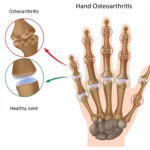osteoarthritis in patient at high gastric ulcer risk: Osteoarthritis (OA) is a progressive joint disease characterized by cartilage degradation, joint pain, and functional impairment. Nonsteroidal anti-inflammatory drugs (NSAIDs) remain a cornerstone of pharmacologic therapy for OA. However, in patients with a high risk of gastric ulcers, such treatment presents a serious concern due to gastrointestinal (GI) toxicity, including mucosal damage, ulceration, and bleeding.
This unique clinical challenge requires a balanced, individualized approach that prioritizes both effective symptom control and gastrointestinal safety.

Pathophysiology of Osteoarthritis and NSAID-Induced GI Injury
Osteoarthritis arises from biomechanical stress, cartilage breakdown, subchondral bone changes, and low-grade inflammation. NSAIDs alleviate pain by inhibiting cyclooxygenase (COX) enzymes, particularly COX-2, which is involved in inflammation.
However, inhibition of COX-1, essential for gastric mucosal protection, leads to reduced prostaglandin synthesis, compromising gastric lining integrity and increasing ulcer risk.
Patients with predisposing factors require special attention to prevent potentially life-threatening gastrointestinal complications.
Identifying Patients at osteoarthritis in patient at high gastric ulcer risk
Proper risk stratification is critical in osteoarthritis patients. The following factors contribute to increased GI risk:
High-Risk Criteria:
- Age ≥ 65 years
- History of peptic ulcer disease or GI bleeding
- Concurrent use of anticoagulants or corticosteroids
- High-dose or prolonged NSAID use
- Presence of Helicobacter pylori infection
- Smoking and alcohol use
Such patients warrant alternative treatment strategies or protective interventions to minimize GI damage.
Non-NSAID Pain Management Options
Acetaminophen (Paracetamol)
A widely used first-line therapy for mild to moderate OA pain, acetaminophen offers a favorable GI safety profile. However, it lacks anti-inflammatory effects and may be insufficient in advanced OA.
Topical NSAIDs
Topical diclofenac and ketoprofen deliver pain relief directly to the affected joint with minimal systemic absorption, thereby bypassing GI mucosa. Particularly effective in superficial joints such as the hands and knees.
Duloxetine
An SNRI antidepressant that has shown efficacy in chronic musculoskeletal pain and knee OA. It modulates central pain pathways without affecting the gastrointestinal tract.
Tramadol
A centrally acting opioid analgesic, tramadol can be used short-term for moderate to severe pain in high GI-risk patients, but should be used with caution due to potential side effects and dependency.
COX-2 Selective Inhibitors: A Safer NSAID Class
COX-2 inhibitors (e.g., celecoxib) were developed to reduce inflammation while sparing COX-1, thereby reducing GI toxicity.
Key Benefits:
- Lower risk of gastric ulcers compared to traditional NSAIDs
- Effective for OA-related pain and stiffness
Considerations:
- Cardiovascular risk assessment is essential
- Use at the lowest effective dose for the shortest duration
For patients with both cardiovascular and GI risks, co-therapy with a proton pump inhibitor (PPI) may be required.
Gastroprotective Strategies in OA Treatment
To minimize ulcer risk when NSAID therapy is unavoidable, gastroprotection is paramount.
Proton Pump Inhibitors (PPIs)
- Examples: omeprazole, esomeprazole, pantoprazole
- Highly effective in reducing NSAID-induced ulcers
- Should be co-prescribed in all high-risk patients
H2-Receptor Antagonists
- Less effective than PPIs, but may offer modest protection at high doses
Misoprostol
- A prostaglandin analog that protects gastric mucosa
- Effective but often poorly tolerated due to diarrhea and abdominal cramping
Non-Pharmacologic Interventions
In high GI-risk patients, non-pharmacologic therapies play a central role in reducing reliance on medications.
Weight Management
Excess body weight significantly increases joint loading, particularly in the knees. Even modest weight loss improves symptoms.
Physical Therapy and Exercise
Tailored programs focusing on strengthening, flexibility, and aerobic conditioning reduce pain and enhance mobility.
Assistive Devices
Braces, orthotics, and walking aids can help reduce joint stress and improve function.
Heat and Cold Therapy
Used adjunctively to manage stiffness and inflammation.
Surgical Options for Advanced OA
When conservative treatments fail, surgery may be considered, especially in high GI-risk individuals for whom chronic NSAID use is unsuitable.
Total Joint Replacement
Highly effective for severe hip or knee OA, offering long-term relief and restored mobility.
Joint Preservation Techniques
Osteotomy or arthroscopic debridement may be appropriate for select patients with less advanced disease.
Clinical Recommendations and Best Practices
- Always assess GI risk before initiating NSAID therapy in OA patients.
- Prefer topical agents or non-NSAID oral medications when feasible.
- If NSAIDs are essential, use COX-2 inhibitors with PPI co-therapy.
- Educate patients about symptom monitoring and early warning signs of GI bleeding.
- Integrate lifestyle modifications to reduce pharmacological dependence.
Frequently Asked Questions:
What is the safest painkiller for osteoarthritis with ulcer risk?
Topical NSAIDs and acetaminophen are generally the safest options. COX-2 inhibitors with PPIs can be considered under supervision.
Can I take ibuprofen if I have a history of ulcers?
Not without protection. Ibuprofen increases the risk of ulcers and should be avoided or combined with a PPI in high-risk individuals.
Are COX-2 inhibitors completely safe for the stomach?
They are safer than non-selective NSAIDs but not entirely without GI risk. Always assess individual risk and co-prescribe a PPI if needed.
Can osteoarthritis be managed without medication?
Yes, through weight loss, physical therapy, lifestyle changes, and assistive devices. These can significantly reduce the need for medication.
Do PPIs reduce the effectiveness of NSAIDs?
No, PPIs protect the gastric lining without affecting the anti-inflammatory benefits of NSAIDs.
Managing osteoarthritis in patients at high risk of gastric ulcer requires a nuanced, multi-modal approach. Clinicians must weigh the benefits of pain relief against the potential for GI harm, especially in the elderly and those with comorbid conditions. By integrating safer pharmacologic alternatives, gastroprotective strategies, and non-drug therapies, we can offer effective symptom control without compromising gastrointestinal safety.

